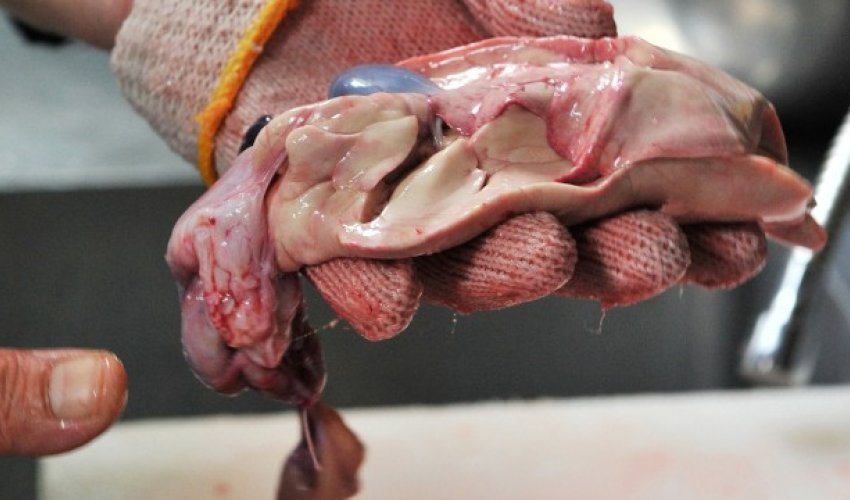Japan's puffer fish capital: Delicious and deadly - PHOTO

It's 3:15 a.m.Under the bright lights of the waterfront Haedomari warehouse in Shimonoseki, Japan, tails twitch and bodies writhe in defiance of the onset of death.The floor is awash with seawater as Yoshi Yanagawa moves down a line of 20 boxes, each containing about 15 puffer fish of varying values, lengths and states of coveted plumpness."Eeka! Eeka!" he chants, as 20 or so interested parties put their hands up to bid.The puffer fish, or "fugu" in Japanese, gulp in more air, ballooning out their white belly sacs.Shimonoseki is Japan's fugu capital.Its Haedomari market is said to be the only one in the country that specializes in the infamous Japanese delicacy, famed both for its high price tag and lethal insides.Throughout the fishing season from early September to April 29, the market is open six mornings a week in the ancient port, 1,126 kilometers west of Tokyo in Honshu's most southwesterly part of Yamaguchi prefecture.For 15 years, 55-year-old Yanagawa has been the chief auctioneer ("seri" or "sekagi") here."My job is unusual," says Yanagawa."Grown men squeeze my hand and fingers. They touch me every morning! It's the traditional way of fugu bidding."I hold my slipover sleeve or 'fukuro zeri' out to them and they put their hands inside and tell me how much they want to pay. It's all done by finger pressure."Ancient Egyptian bowling fish?When the auction is over, the sold fugu is packed into polystyrene boxes and taken away to the city's 10 processing factories.All are specially licensed to prepare and detoxify the fish in accordance with Japanese law.It's an important step, given fugu is hundreds of times more poisonous than cyanide, containing enough toxin in its liver alone to kill five men.Western Australia's Department of Fisheries says puffer fish are the second most poisonous vertebrate in the world after the golden poison frog.The ovaries, roe and kidneys are just as deadly as the liver -- all of which are incinerated after processing.One milligram of the fugu's tetrodotoxin is enough to bring on an agonizing death within an hour of being consumed.Yet "takifugu rubripes" (the official species name) is still the epitome of gourmet dining in Japan.Tokyo restaurant-goers are prepared to pay 22,000 yen ($210) for a near-death experience at high-end restaurants like three Michelin-starred Usukifugu Yamadaya, or the more moderately priced Torafugu Tei.In recent years, fish breeders have reportedly developed a non-toxic variety by restricting the fugu's diet, though the poison-filled version is as popular as ever.The threat of death is perhaps part of its allure."Paintings of fugu have been found in the tombs of ancient Egypt," says Toshiharu Hata, who runs one of the largest fugu wholesale businesses in Shimonoseki."The Egyptians used the fish to play a primitive version of bowling."Hata's fugu history lesson doesn't end there."Captain Cook bought a fugu from the natives of New Caledonia and it killed a pig on board 'The Resolution,'" he adds."The most famous human fatality happened in 1975 when Mitsugoro Bando VIII, a Kabuki actor, died after eating four portions!""Every dish is a work of science"Hata, whose father founded his family's fish company 40 years ago, explains that fugu is traditionally served in transparent paper-thin strips on painted porcelain plates."Master chefs cut them into the shapes of chrysanthemum petals, Mount Fuji or into animals like peacocks, turtles and butterflies," he says. "Every plate is a work of art. Every dish is a work of science."We walk around the factory floor, watching his staff wash and process the precious fish."The best is tiger fugu," says Hata."It sells at 40,000 yen a kilogram; one kilogram will feed 30 people. We ship them to New York. It wasn't until 1988 that we were allowed to export to the United States."But Shimonoseki is the best place to eat it as you get more when you order in a restaurant. Maybe 20 pieces compared to eight in Osaka and Tokyo. Tokuyama City is good too."We stop in front of a man wearing a white coat and a hairnet, expertly filleting a fish with his "hochi" knife.He bows."He's in charge of our fish testicle and genitalia department," says Hata, reverently.A day in ShimonosekiIt's 6:30 a.m. as we drive into Shimonoseki's city center to hit up the Karato-Ichiba fish market (5-50 Karato-machi).Stalls are already set up, selling crabs, squid, sea urchins, clams and numerous types of multi-colored seaweed.Hata leads us to a little curtained-off booth in a corner of the market, one of many eating options here."The Tanabe Shokudu restaurant here is the best in town," he says, kissing his fingers and ordering two hot sakes.On the breakfast menu: raw slices of fresh tuna sashimi and fugu served with black ponzu sauce, followed by deep-fried tempura fugu, and a fugu "chirinabe" casserole with the local "uiro" rice cakes.There's also a fugu broth with sliced scallions, tofu and grated daikon radishes.All delicious, though slightly unnerving.Deadly dining aside, there's more to Shimonoseki and its surrounds than seafood markets.A 13-kilometer ride away from the city center lies the Chofu castle town of Jokamachi, home to Samurai Street, with its yellow walled houses and 14th-century lean-tos.Amid the shrine grounds, Hata explains the tenets of Japan's Bushido warrior class."The Meiji Revolution of 1867 began here," says Hata. "This is the heart of the anti-shogunate movement. Here, Takasugi Shinsaku raised his army."Shimonoseki is the birthplace of modern Japan.Our country opened up to the West from here after a foreign flotilla bombarded the town and the disillusioned samurai persuaded the shogunate to accept foreigners."Other attractions in and around the city worth checking out include: The Shimonoseki Marine Science Museum; Kozanji Temple, a designated National Treasure of Japan; Akama Shrine; the 1,780-meter-long Tsunoshima Bridge, which connects the island of Tsunoshima (part of Shimonoseki city) with Honshu; and Ganryujima, a tiny island famed for being the site of an epic duel between sword legends Miyamoto Musashi and Sasaki Kojirō.Getting thereBy air: domestic airlines operate 90-minute flights from Tokyo's Haneda Airport to Yamaguchi Ube Airport. From there, it's a one-hour bus ride to Shimonoseki Station.By rail: Shimonoseki is a 5 hour, 30 minute train ride from Tokyo via Shin-Yamaguchi on the JR Tokaido-Sanyo Shinkansen Line. From Osaka, it's two-hour, 40-minute ride on the Shinkansen line.(CNN)ANN.Az
Similar news
Similar news
Latest news 
More news 



































 Photo
Photo 



 Video
Video 

